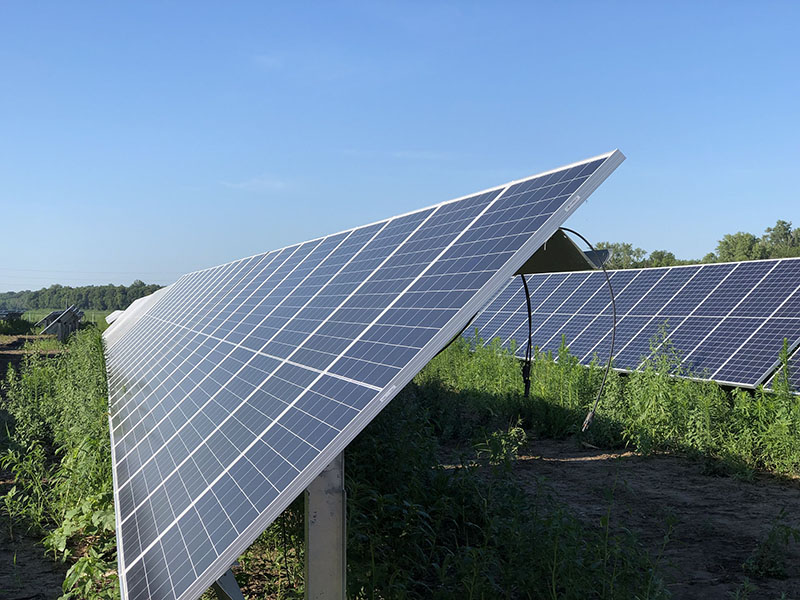OPPD proposes changes focused on large-scale utility solar

OPPD management is seeking approval from its publicly elected board of directors to add generation to its fleet, including what would be the largest utility-grade solar presence in the state.
In addition to between 400 and 600 of megawatts in utility-scale solar with replacement gas backup, the plans also include refueling some of OPPD’s coal assets with natural gas as the oldest units at North Omaha Station (NOS) retire and OPPD integrates more renewables into the system. Along with these additions, OPPD may also pursue adding grid voltage-support devices as the grid continues to evolve.
In total, from 2010 through 2024, OPPD estimates a 30% reduction in carbon dioxide (CO2) emissions.
OPPD President and CEO Tim Burke said the new generation, the details of which would become clearer after requests for proposal are answered, is needed in light of a changing generation and customer landscape.
“This is part of a journey we’ve been on since 2014, when our board of directors approved the retrofitting of North Omaha Station Units 1, 2, and 3 to run on natural gas rather than coal,” Burke said.
At their November meeting, the board could approve a final recommendation and authorize management to negotiate and enter into contracts. The stakeholder process, where customers can provide feedback on the proposal, will be open until Nov. 8 at oppdlistens.com.
Part of overall journey
The journey towards increasing environmentally sensitive generation resulted from OPPD’s stakeholder outreach efforts. Those efforts allowed customers to give feedback on the direction of their public power utility over the years. Burke said the journey has included the following decisions towards more renewable generation:
- Adding almost 1,000 megawatts of wind by the end of 2019
- Retrofitting NOS 1, 2, and 3 to run on natural gas by 2016 and installing emissions control measures on units 4 and 5, and in 2023 retrofitting them to run on natural gas.
- In 2016, the decision was made to cease operations at Fort Calhoun Station due to economic reasons. That same year, a five-year general rate freeze was announced.
OPPD’s path towards renewables has greatly increased in that time frame. The utility met its original goal for 10% renewables six years early, and, in 2019, sold out its first community solar project. Nebraska may not have the sun intensity of southwestern U.S. states, but there is still plenty of solar power potential, according to the National Renewable Energy Laboratory.
“As we think about all those situations we’re trying to solve for and the rules and regulations we’re required to meet, it’s important for us to think about this next generation of how we’re going to provide service to our customers,” Burke said.
Burke said OPPD’s load continues to grow and the utility must bring on new generation to make up for not just retired coal units at NOS and the decommissioning of FCS, but other generation retirements around the region. Beyond Nebraska, other utilities have retired units as well, such as those at MidAmerican Energy’s George Neal and Walter Scott power plants in Iowa.
Such retirements present challenges for utilities around the region and nation.
“The recommendation of our team comes after thoughtful and careful analysis of available technologies, affordability of options and what solutions might best fit our needs,” Burke said. “The result is an approach that truly allows OPPD to lead the way we power the future.”
Meeting obligations
OPPD also has a legal obligation to serve all customers in its territory. It must maintain certain reliability standards set by regulators such as the Federal Energy Regulatory Commission, the North American Electric Reliability Corporation, the Southwest Power Pool and the State of Nebraska.
Regulations call for OPPD to guarantee a supply of power over 12% of the utility’s highest level of peak demand. Such regulations ensure the North American transmission grid remains reliable for its customers, in simplest terms, keeping the lights on for everyone.
Beyond regulatory requirements for reliability, Burke said it is also important for the utility to put a high emphasis on resiliency.
Mary Fisher, vice president of Energy Production & Nuclear Decommissioning, said OPPD’s electrical system has been tested like it hasn’t been in years. But these proposals would go a long way in helping ensure OPPD maintains its high levels of resiliency and reliability.
Fisher pointed to the past two years: “We have seen multiple storms, flooding and two tornadoes that took out six transmission lines in one fell swoop. During the flooding we had to run peaking units for a nearly a week straight because Nebraska City Station Unit 1 was in a planned maintenance outage and we had to shut down Unit 2 for the safety of our workers and contractors. The peaking units kept the power on for our customers. We are planning differently and need sufficient resiliency on our system to cover these multi-day outage situations.”
Modernizing and reinforcing
Fisher said OPPD’s system resiliency allowed the utility to remain reliable for customers during those situations, but region-wide generation retirements are testing resiliency for the entire region.
Due to resiliency and reliability needs, OPPD is asking the board to approve procuring natural gas generation assets. These additions provide support through the NOS transition from coal to natural gas, and for the solar facility when needed. This would help power the service territory when renewables aren’t available.
Voltage-control measures maintain a consistent quality of electricity for OPPD’s customers. These devices work much like water pressure in pipes, providing consistency of water pressure when the faucet is turned on.
An OPPD cross-functional team initially looked at 70 million scenarios before whittling it down to a workable number and landing on one that aligns with the utility’s mission and vision.
The board will hear the proposal during its committee and regular meetings on Oct. 15 and 17 respectively. At the November board meeting, OPPD management will ask the board to grant authority to negotiate and award contracts to obtain these new assets.

Jason Kuiper joined OPPD as a communications specialist in 2015. He is a former staff writer and reporter at the Omaha World-Herald, where he covered a wide range of topics but spent the majority of his career covering crime. He is a graduate of the University of Nebraska at Omaha and has also appeared in several true crime documentary shows. In his free time he enjoys cooking, spending time with his wife and three children, and reading crime novels.
View all posts by Jason Kuiper >





